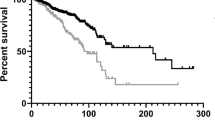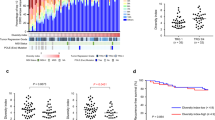Abstract
Purpose
In certain cancer settings, a T-cell response to cancer represents a relatively favorable outcome. Thus, the near-future challenges include a better understanding of exactly which T-cell features contribute to a response to which cancer antigen-groups, to maximize the opportunities for tumor-infiltrating lymphocyte (TIL)-based therapies and other immunotherapies.
Methods
The immune receptor complementarity determining region-3 (CDR3) is considered to be important for antigen binding, hence, in this report, we evaluated the chemical features of the CDR3 of 846 T-cell receptor-α (TCR-α) coding regions associated with bladder tumor tissue, using bioinformatics databases.
Results
Results indicated that statistically significantly distinct, low value, CDR3 region isoelectric points associate with a better outcome (log rank p < 0.027, overall survival). Moreover, in samples representing the more favorable isoelectric points, known driver mutations, for example, PIK3CA (E → K) with chemically complementary features overlap the better-outcome, low isoelectric point samples. Further work extended these results, i.e., survival rate-CDR3 associations, to other CDR3 chemical features and other cancers, consistent with the initial isoelectric point-related, bladder cancer findings.
Conclusions
A bioinformatics assessment of cancer-associated TCR biochemical features may improve the accuracy of the predictions of which TILs will be best for ex-vivo amplification and which patients will benefit from other immunotherapies.




Similar content being viewed by others

Abbreviations
- BLCA:
-
Bladder cancer
- CDR3:
-
Complementarity determining region-3
- DFS:
-
Disease-free survival
- ESCA:
-
Esophageal carcinoma
- NCPR:
-
Net charge per residue
- OS:
-
Overall survival
- OVCA:
-
Ovarian cancer
- STAD:
-
Stomach adenocarcinoma
- TCR:
-
T-cell receptor
- TCGA:
-
The cancer genome atlas
- TILs:
-
Tumor-infiltrating lymphocytes
- WXS:
-
Whole exome sequence
References
Brown SD, Raeburn LA, Holt RA (2015) Profiling tissue-resident T cell repertoires by RNA sequencing. Genome Med 7:125
Callahan BM, Tong WL, Blanck G (2018a) T cell receptor-beta J usage, in combination with particular HLA class II alleles, correlates with better cancer survival rates. Immunol Res 66:219–223
Callahan BM, Yavorski JM, Tu YN, Tong WL, Kinskey JC, Clark KR, Fawcett TJ, Blanck G (2018b) T-cell receptor-beta V and J usage, in combination with particular HLA class I and class II alleles, correlates with cancer survival patterns. CII, Cancer immunology
Chen SA, Tsai MH, Wu FT, Hsiang A, Chen YL, Lei HY, Tzai TS, Leung HW, Jin YT, Hsieh CL, Hwang LH, Lai MD (2000) Induction of antitumor immunity with combination of HER2/neu DNA vaccine and interleukin 2 gene-modified tumor vaccine. Clin Cancer Res 6:4381–4388
Cheng L, Guo Y, Zhan S, Xia P, Association between HLA-DP gene polymorphisms and cervical cancer risk: a meta-analysis, Biomed Res Int, 2018 (2018) 7301595
Davila ML, Kloss CC, Gunset G, Sadelain M (2013) CD19 CAR-targeted T cells induce long-term remission and B Cell Aplasia in an immunocompetent mouse model of B cell acute lymphoblastic leukemia. PloS One 8:e61338
Di Sante G, Tolusso B, Fedele AL, Gremese E, Alivernini S, Nicolo C, Ria F, Ferraccioli G (2015) Collagen specific T-cell repertoire and HLA-DR alleles: biomarkers of active refractory rheumatoid arthritis. EBioMedicine 2:2037–2045
el-Demiry MI, Smith G, Ritchie AW, James K, Cumming JA, Hargreave TB, Chisholm GD (1987) Local immune responses after intravesical BCG treatment for carcinoma in situ. Br J Urol 60:543–548
Gill TR, Samy MD, Butler SN, Mauro JA, Sexton WJ, Blanck G (2016) Detection of productively rearranged TcR-alpha V-J sequences in TCGA exome files: implications for tumor immunoscoring and recovery of antitumor T-cells. Cancer Inf 15:23–28
Iglesia MD, Parker JS, Hoadley KA, Serody JS, Perou CM, Vincent BG (2016) Genomic analysis of immune cell infiltrates across 11 tumor types. J Natl Cancer Inst 108
Kinskey JC, Tu YN, Tong WL, Yavorski JM, Blanck G (2018) Recovery of immunoglobulin vj recombinations from pancreatic cancer exome files strongly correlates with reduced survival. Cancer Microenviron
Klarenbeek PL, Doorenspleet ME, Esveldt RE, van Schaik BD, Lardy N, van Kampen AH, Tak PP, Plenge RM, Baas F, de Bakker PI, de Vries N (2015) Somatic variation of T-cell receptor genes strongly associate with HLA class restriction. PloS One 10:e0140815
Kochenderfer JN, Dudley ME, Kassim SH, Somerville RP, Carpenter RO, Stetler-Stevenson M, Yang JC, Phan GQ, Hughes MS, Sherry RM, Raffeld M, Feldman S, Lu L, Li YF, Ngo LT, Goy A, Feldman T, Spaner DE, Wang ML, Chen CC, Kranick SM, Nath A, Nathan DA, Morton KE, Toomey MA, Rosenberg SA (2015) Chemotherapy-refractory diffuse large B-cell lymphoma and indolent B-cell malignancies can be effectively treated with autologous T cells expressing an anti-CD19 chimeric antigen receptor. J Clin Oncol 33:540–549
Li B, Li T, Pignon JC, Wang B, Wang J, Shukla SA, Dou R, Chen Q, Hodi FS, Choueiri TK, Wu C, Hacohen N, Signoretti S, Liu JS, Liu XS (2016) Landscape of tumor-infiltrating T cell repertoire of human cancers. Nature genetics 48:725–732
Li B, Li T, Wang B, Dou R, Zhang J, Liu JS, Liu XS (2017) Ultrasensitive detection of TCR hypervariable-region sequences in solid-tissue RNA-seq data. Nat Genet 49:482–483
Lopez-Knowles E, Hernandez S, Malats N, Kogevinas M, Lloreta J, Carrato A, Tardon A, Serra C, Real FX (2006) PIK3CA mutations are an early genetic alteration associated with FGFR3 mutations in superficial papillary bladder tumors. Cancer Res 66:7401–7404
Mai AT, Tong WL, Tu YN, Blanck G (2018) T-cell receptor-alpha recombinations in renal cell carcinoma exome files correlate with an intermediate level of T-cell exhaustion biomarkers, International immunology
Parodi A, Traverso P, Kalli F, Conteduca G, Tardito S, Curto M, Grillo F, Mastracci L, Bernardi C, Nasi G, Minaglia F, Simonato A, Carmignani G, Ferrera F, Fenoglio D, Filaci G (2016) Residual tumor micro-foci and overwhelming regulatory T lymphocyte infiltration are the causes of bladder cancer recurrence. Oncotarget 7:6424–6435
Prescott S, James K, Busuttil A, Hargreave TB, Chisholm GD, Smyth JF (1989) HLA-DR expression by high grade superficial bladder cancer treated with BCG. Br J Urol 63:264–269
Samy MD, Tong WL, Yavorski JM, Sexton WJ, Blanck G (2017) T cell receptor gene recombinations in human tumor specimen exome files: detection of T cell receptor-beta VDJ recombinations associates with a favorable oncologic outcome for bladder cancer. Cancer Immunol, Immunother 66:403–410
Stober U (1978) Influence of T-lymphocytes in bladder cancer on appearance and infiltration of recurrences (author’s transl). Urologe A 17:296–302
Tong WL, Tu YN, Samy MD, Sexton WJ, Blanck G (2017) Identification of immunoglobulin V(D)J recombinations in solid tumor specimen exome files: evidence for high level B-cell infiltrates in breast cancer. Hum Vac Immunother 13:501–506
Tu YN, Tong WL, Samy MD, Yavorski JM, Kim M, Blanck G (2017a) Assessing microenvironment immunogenicity using tumor specimen exomes: co-detection of TcR-alpha/beta V(D)J recombinations correlates with PD-1 expression. J Int Cancer
Tu YN, Tong WL, Fawcett TJ, Blanck G (2017b) Lung tumor exome files with T-cell receptor recombinations: a mouse model of T-cell infiltrates reflecting mutation burdens. Lab Invest 97:1516–1520
Tu YN, Tong WL, Yavorski JM, Blanck G (2018) Immunogenomics: a negative prostate cancer outcome associated with TcR-gamma/delta recombinations. Cancer Microenviron
Zeng G, Huang Y, Huang Y, Lyu Z, Lesniak D, Randhawa P (2016) Antigen-specificity of T cell infiltrates in biopsies with T cell-mediated rejection and BK polyomavirus viremia: analysis by next generation sequencing. Am J Transpl 16:3131–3138
Acknowledgements
Authors wish to acknowledge the support of USF research computing and the taxpayers of the State of Florida.
Author information
Authors and Affiliations
Corresponding author
Ethics declarations
Conflict of interest
Authors have nothing to declare.
Ethical approval
This article does not contain any studies with human participants or animals performed by any of the authors.
Rights and permissions
About this article
Cite this article
Chobrutskiy, B.I., Zaman, S., Diviney, A. et al. T-cell receptor-α CDR3 domain chemical features correlate with survival rates in bladder cancer. J Cancer Res Clin Oncol 145, 615–623 (2019). https://doi.org/10.1007/s00432-018-2815-1
Received:
Accepted:
Published:
Issue Date:
DOI: https://doi.org/10.1007/s00432-018-2815-1



